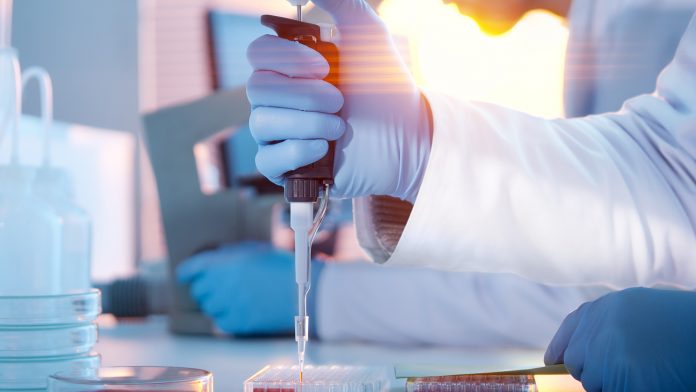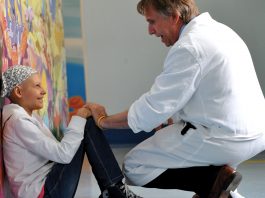Bertrand Tombal from Service d’Urologie, Cliniques Universitaires Saint Luc and EORTC’s Davi Kaur, Beatrice Fournier, and Laurence Collette, discuss current clinical research into prostate cancer.
The purpose of the European Organisation for Research and Treatment of Cancer (EORTC) is to co-ordinate and conduct international translational and clinical research to improve the standard of cancer treatment for patients. It aims ultimately to increase people’s survival and quality of life by testing new therapeutic strategies based on existing drugs, surgery and radiotherapy, and it helps develop new drugs and approaches in partnership with the pharmaceutical industry and in patients’ best interests.
Here, EORTC’s Davi Kaur, Beatrice Fournier, and Laurence Collette, and Bertrand Tombal from Service d’Urologie, Cliniques Universitaires Saint Luc, answer The Innovation Platform’s questions around clinical research into prostate cancer treatments, as well as some of the main misconceptions around this form of disease.
What role does the EORTC play, and why/how does the current standard of cancer treatment in Europe need to be improved?
EORTC is a unique pan-European non-profit clinical cancer research organisation established in 1962. Its research spans the entire spectrum from translational and preclinical research to large, prospective, multi-centre, phase III clinical trials that evaluate new cancer therapies and/or treatment strategies as well as patient quality of life in multiple tumour types. This is achieved through the development of new innovative approaches, and the testing of more effective therapeutic strategies, using drugs still in early stage of development or already approved drugs, surgery and/or radiotherapy. These clinical trials are conducted by a vast network of over 5,300 multidisciplinary clinical researchers, in more than 900 university hospitals and cancer institutions, in over 30 countries. 240 staff members based in Brussels support the EORTC network and its research. EORTC has the expertise to conduct large and complex trials especially in specific populations such as the older patient and rare tumours. As such, EORTC is the only pan-European organisation studying all solid cancer and every available treatment modality.
In Europe, cancer is the second largest cause of deaths, just after deaths by diseases of the circulatory systems. In 2016, it was estimated that over 1.3 million people in the European Union died of cancer. Men (769,344 deaths due to cancer) were more affected than women (613,369). In addition, cancers represented 28% of all deaths for the EU population aged less than 65, while this level was below a quarter (24%) for the older population (those aged 65 years and over).
Lung cancer remains the leading cause of death, 21% of all deaths due to this cancer followed by colorectal cancer (12%), breast cancer (16%), pancreas cancer (6%) and prostate cancer (10% of all cancers for the male population only) (Reference: Eurostat). Prostate cancer is the most commonly diagnosed cancer in men, with more than 417,000 new cases and 92,000 deaths in Europe recorded each year. Currently, one in seven men in Europe will develop detectable prostate cancer before the age of 85. More than two million men in Europe are living with this disease today.
If most localised cancer can be cured by surgery or radiotherapy, there is no absolute cure for advanced cancer. However, with the improvement of better multidisciplinary cancer care, there has been an increase in the survival rate of cancer patients, (more than 80% of women now survive breast cancer, for instance). Our knowledge on how cancer evolves at a cellular and molecular level has helped to develop more precision medicine, targeting the cancer cells with novel drugs such as imatinib for GIST tumours.
While the progresses made over the last 10 years largely results from a massive development of new drugs by the pharmaceutical industry, EORTC has been concerned that clinical cancer research has not been patient-centred enough. A recent survey suggests that only 30% of drugs currently available give a meaningful clinical benefit to patients, yet cause an enormous increase in healthcare expenditures. This is why EORTC is actively lobbying EU parliament to have an independent, patient centred societal approach to decision making in health care systems. It views that treatment optimisation studies, addressing the question of what the best treatment regimen, and the duration of treatment for every patient should be integrated into drug development and taken into account when regulators, payers, and clinicians take decisions.
Finally, there are large disparities in the treatment of cancer care across Europe. The access and affordability to treatment is determined by each country’s healthcare system, and the quality of cancer care is dependent on how national and regional health authorities follow clinical cancer guidelines.
What are some of the latest findings from the EORTC Genito Urinary Cancers Group on prostate cancer?
The EORTC Genito-urinary Cancers Group (GUCG) was created in 1976 and has produced over 150 peer reviewed publications. The group’s research has focussed on the role of hormonal therapy in advanced and metastatic prostate cancer and the benefit of adjuvant external beam radiation therapy (EBRT). New therapies in castration resistant prostate cancer have also been investigated. With the collaboration of the EORTC Radiation Oncology Group, the group has produced practice-changing studies that improve outcomes by treatment from radiotherapy, mostly by showing that hormonal treatment, used for various durations, synergize the effect of radiotherapy.
Most recently, the GUCG has focused on combinations of newly-approved drugs in patients progressing on hormone therapy. Indeed, at least four drugs have been developed simultaneously, thus not addressing sequence or combination properly.
One of this trial, EORTC 1333/PEACE III, address the combination of a second-line hormonal treatment, enzalutamide, with an injectable radionuclide targeting bone metastases, RA-223. That study mirrors another trial, ERA-223 assessing the combination of abiraterone, another widely used hormone, and RA223. ERA-223 unfortunately led to dramatic results, demonstrating a prohibitive increase in the rate of frailty fractures and death when abiraterone and RA223 were combined.
The interim results of the EORTC 1333 trial, presented at ASCO 2019, suggest that this increased risk was mostly driven by patients not receiving adequate bone protective therapy, as recommended by the guidelines. Overall, 45% of the patients were treated without bone protecting agents and their median follow-up is 20 months, and 55% were treated with bone protection. The median follow-up of this group is only 13 months. At one year, there was a 12.4% cumulative risk of fracture with enzalutamide that increased to 37.4% when Ra223 is added to enzalutamide. However, with mandatory continuous administration of bone protecting agents starting at least six weeks before the first injection of Ra-223, the cumulative risk at one year was almost abolished with zero fractures on enzalutamide alone and 2.2% with the combination.
EORTC 1333 can thus be seen as a practice-changing trial leading to better patient care.
What is the benefit of external beam radiation therapy in relation to prostate cancer?
Like prostatectomy, radiotherapy is an established, localised treatment with curative intent in early disease stages. EORTC has conducted one of the two international trials, EORTC-22911, testing the value of postoperative radiotherapy after radical prostatectomy for patients with poor risk features, (the other trial being a SWOG trial S9346). These trials set the foundations for more recent trials suggesting early salvage treatment with radiotherapy in case of recurrence after surgery for localized prostate cancer.
Irradiation in combination with hormonal therapy is also the mainstay of treatment of patients with intermediate or high risk localised or locally advanced disease. EORTC conducted two trials in patients with high risk features (EORTC-22963 and EORTC-22961) and a trial in intermediate risk is about to release its results (EORTC-22991), while we also contribute to other trials assessing such combinations (trials in collaboration with Australian group).
EORTC-1201-GUCG-ROG – PEACE-1 is a prospective randomised phase III study of androgen deprivation therapy with or without local radiotherapy and with or without abiraterone acetate and prednisone in patients with metastatic hormone-naive prostate cancer. Conducted with UNICANCER, the trial tests the benefit of irradiating the prostate in patients who are otherwise metastatic and who receive systemic hormonal treatment. Finally, irradiation targeted to metastases is also now being used in patients who present with oligometastatic disease.
What are some of the most common misconceptions associated with prostate cancer?
Many people may believe that prostate cancer only affects older men. And while prostate cancer risks, like all cancers, do indeed increase with age, we nevertheless often see incidence rates rise steeply as of age 50-54, peak in the 75-79 years-old population, before dropping slightly and remaining stable in the over 80 population. The highest rates observed are in those aged 75-79.
There is also the misconception that prostate cancer causes symptoms, and that men without urinary symptoms have no prostate cancer. Most localised prostate cancer (those that are curable by surgery or radiotherapy) develop in men without symptoms. That is why a discussion about a man’s individual risk of prostate cancer should be discussed with a GP in absence of any symptoms at the age of 50, and even before if close relatives have been diagnosed with prostate cancer. The patient and their physician can then decide whether to perform a digital rectal examination and a PSA test.
Waiting until symptoms such as bone pain, changes in urination, and pelvic pain occur before consulting may mean that the cancer has become very advanced and the cancer has left the prostate. However, symptoms in the pelvic area can also be due to other health problems such as BPH, urinary tract infection, and sexually transmitted diseases.
It is also incorrect to assume that prostate cancer is always deadly. Prostate cancer has many grades separated into ‘risk categories’, which are based on what is called a WHO ISUP grade grouping (1-5), determined by examining cancer tissues taken from the prostate for signs of aggression. Most cancer diagnosed with PSA are classified ISUP 1-2 and can be actively monitored, the risk of death being around 1% at 10 years. Prostate cancer classified with an ISUP 3-5 can spread to the rest of the body and is occasionally fatal. Treatment is recommended for these men, either in the form of surgery or radiation with a hormonal blocker. Whereas men diagnosed with Gleason 6 and under can be closely monitored without immediate treatment, in what is known as ‘active surveillance’.
Finally, it is also not true that recurrence of prostate cancer means certain death. Prostate cancer is not like other cancers. A man previously treated for prostate cancer with a recurrence can still have more than 13 years ahead of him. Progress in treating a metastatic disease at different sites throughout the body is being made constantly with effective new technologies and new medications being identified. As tumour genetics is becoming increasingly accurate, genetically targeted approaches adapted to individuals are becoming a reality.
Bertrand Tombal
Service d’Urologie, Cliniques Universitaires Saint Luc, Brussels, Belgium
Davi Kaur
Beatrice Fournier
Laurence Collette
European Organisation for Research and Treatment of Cancer (EORTC)
+32 2 774 1513
davi.kaur@eortc.org
Tweet @EORTC
www.eortc.org
Please note, this article will also appear in the second edition of our new quarterly publication.









